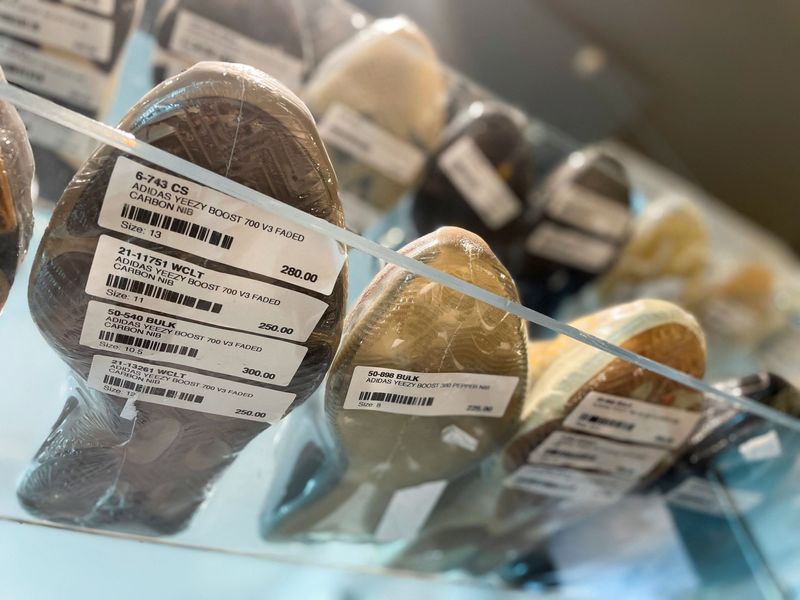China turnaround challenge dwarfs Adidas’ Yeezy debacle
2023.05.05 06:17

© Reuters. FILE PHOTO: Adidas Yeezy shoes are seen in a store on the day Adidas terminated its partnership with the American rapper and designer Kanye West, now known as Ye, in Garden City, New York, U.S., October 25, 2022. REUTERS/Shannon Stapleton
By Casey Hall
SHANGHAI (Reuters) -A potential 500 million euro ($551 million) write-off on unsold Yeezy shoes is a headache for Adidas (OTC:) as it looks to implement a global turnaround – but it’s not the German sportswear giant’s biggest problem.
That would be China, the world’s second-largest sportswear market, where Adidas saw sales decline 36% in its last fiscal year.
“Their numbers there have been just abysmal. They’ve clearly lost market share, and that has a bigger impact in the long term than even Yeezy does,” said Morningstar analyst David Swartz.
First-quarter sales in Greater China fell by 9.4% in currency-neutral terms from the same period last year, Adidas reported on Friday.
Though it is hard to find a global consumer brand that wasn’t negatively impacted by China’s zero-COVID restrictions in 2022, Adidas’ fall was more precipitous than its peers.
Its problems in the China market were apparent long before rolling lockdowns hit Chinese consumer sentiment and retail sales last year.
Since 2019 Adidas has seen its market share in China fall from 19% to 11%, according to Euromonitor figures, allowing local giant Anta to leapfrog into second place in terms of sportswear market share behind Nike (NYSE:).
Adidas was also impacted more heavily than peers by 2020’s Xinjiang cotton controversy, CMBI analyst Walter Woo says, in which Western brands came under attack on Chinese social media over their comments on labour conditions in the province.
A marketing strategy heavy on lifestyle and celebrity ambassadors rather than sportspeople and performance meant celebrities’ pullback from foreign brand endorsements left Adidas less visible in the market.
New CEO Bjorn Gulden flagged in March that Adidas would increase its focus on sports in China, especially soccer and marathons, and sponsor more Chinese athletes.
That has started to bear fruit, with Gulden saying on Friday the sell-through rate – or the percentage of product held in inventory that went on to be sold – was at double-digit levels in the first quarter in the wholesale business and Adidas’ own stores.
“That means that the demand in the market is now higher than it was last year in Q1,” he said. “For the first time… (in) the last two and a half years, we are actually optimistic that the numbers will turn from red to green.”
China market head Adrian Siu, himself only in his role a year, has begun a multi-pronged turnaround strategy for the market that includes a focus on “hyperlocalisation” and speed, Adidas China insiders told Reuters.
Gulden on Friday said Adidas aims for 50% of the apparel it sells in China to be designed specifically for the Chinese market. Much of it, but not all, will also be designed in China, he said.
Currently some 10% of the products the company sells in China are designed locally.
Three sources, who requested anonymity because they aren’t authorised to speak to the media, said this local focus was apparent not only in lifting the proportion of locally designed product for the market, but also in internal company culture.
Since Hong Kong-native Siu took the helm, meetings have been held in Chinese rather than English, sources said. Another Adidas China source said speed to market is now seen as key, as Chinese consumers relentlessly seek newness.
($1 = 0.9073 euros)







